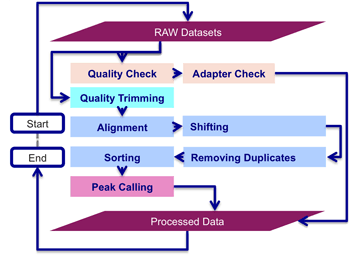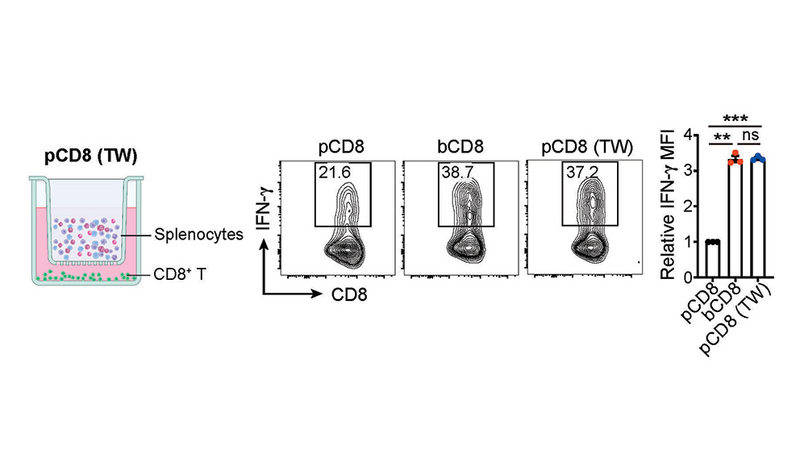Settings
Save and close
The focus of our research is toward the application of a novel epigenetic profiling assay for transposase-accessible chromatin with high throughput sequencing (ATAC-seq) for integrative epigenomic analysis (Buenrostro et al., 2013). ATAC-seq is a new protocol to capture open chromatin sites by performing adaptor ligation and fragmentation of open chromatin regions. Due to its efficiency in requirement of biological sample and in library preparation time, many scientists are generating ATAC-seq libraries to decipher the chromatin landscape of DNA in a given cell type and condition of interest.

ATAC-seq data processing pipeline’s workflow starts with the quality check and adapter trimming, then alignment, shifting, removing duplicates, sorting and peak calling is performed to find significant numbers of mapped reads, indicating the presence of gene regulatory regions. Implementation of ATAC-seq data processing pipeline is a complex task for biologist (without programming skills), as it involves the I/O (input/output) redirectional integration of several non-interactive command-line applications in Unix, Linux and DOS environments.
Here, we present I-ATAC (Interfacing Assay for Transposase-Accessible Chromatin with high-throughput Sequencing) as the interactive, user-friendly, cross platform and open source desktop application, which supports transparent, reproducible and automatic generation of ATAC-seq data quality check and pre-processing.

I-ATAC integrates several non-interactive mode applications for quality checking, adapter trimming, alignment, shifting, removing duplicates, sorting and peak calling by automatically generating and running sequential, multiple-parallel and customized data analysis pipelines.
Its performance has been tested and delivered direct results on a private and public large-scale datasets which can be visualized using available genome browsers, for differential expression analysis to find significant numbers of mapped reads, indicating the presence of gene regulatory region in the genome.
I-ATAC following features:
The targeted end users of I-ATAC are mainly the biologists, who are used to of interactive operating systems (e.g. Windows, Mac-OS-X) and have no programming experience in command-line environment. I-ATAC is a user-friendly desktop application, based on the fundamental software engineering principles and human computer interaction guidelines. It is programmed in Java and requires Java Runtime Environment to be installed on in-use operating system (e.g. Windows, MacOSX etc.). Additionally, it compels all integrated applications to be downloaded and installed in data cluster and referenced genome for mapping.

Download I-ATAC
I-ATAC is very easy to install, cross platform application, freely available to download and use.
Download - I-ATAC for MAC OS X
Download - I-ATAC FOR WINDOWS OS
To learn more about I-ATAC please contact:
Asst. Prof. Duygu Ucar, Ph.D.
Email: [email protected]

How working with genetically diverse could revolutionize our understanding of human disease and treatment.

Diverse mouse models show promise in how we understand and treat diseases, offering a significant improvement over standardized but limited mouse and cellular models.

Mice don’t get Alzheimer’s—and while that’s good news for mice, it’s a big problem for biomedical researchers seeking to understand the disease and test new treatments. Now, researchers at The Jackson Laboratory are working to create the first strain of mice that’s genetically susceptible to late-onset Alzheimer’s, with potentially transformative implications for dementia research.

Charles Lee co-leads the Human Genome Structural Variation Consortium and is uncovering structural variations in the human genome.

Genetic testing is a powerful tool in the fight against cancer, playing a crucial role in both prevention and personalized treatment. But what exactly are the different types of genetic tests, and how do they help?

Explore five research tools and methods that didn't exist ten years ago that could be medical game changers.

Reenergizing exhausted T cells, with help from a rare immune cell known as a basophil, can kickstart the immune system into fighting cancer.

Dan Cortes multifaceted journey has led him to pioneering stem cell research within the Pera lab, where he explores the intricate genetic landscape underlying neurological diseases and disorders.